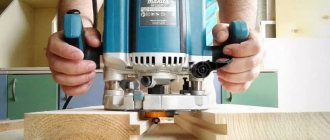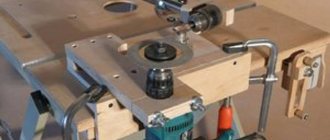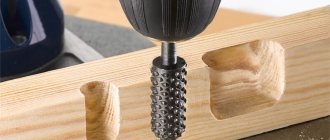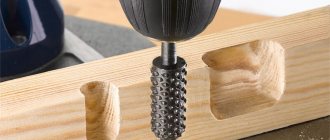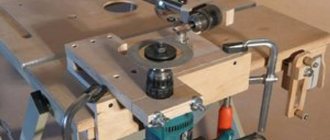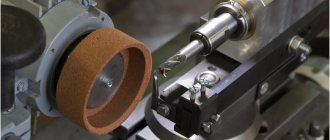To significantly expand the functionality of a conventional drill-only electric drill, you can use a tool such as a wood drill bit. Using a power tool with this working attachment, you can effectively carry out various types of processing of products made from wood materials. By choosing the right cutter for certain tasks, you can use it to perform both roughing and finishing machining.
A drill can perform a number of milling operations
The design of a wood cutter for a drill consists of a shank and a working part, which is initially sharpened for certain technological operations. To perform such sharpening, high-precision equipment is used, the structural elements of which should not have any play. Both the sharpening parameters and the hardness of the material used to make the cutter, which uses special grades of steel, are selected depending on the characteristics of the wood being processed.
All wood cutters are divided into two categories:
- attachments, the diameter of the seating part of which is 32 mm (they are intended for installation in the spindle of a stationary milling machine);
- end ones, which are also called finger-type (their seating part (shank) can have a diameter of 8 or 12 mm; they are installed both on a stationary milling machine and on a hand drill).
Main types of wood cutters
It should be borne in mind that a wood cutter mounted on a drill (as, indeed, metal cutters on a drill) can only be of the end type.
Various types of cutters are used to process various wood materials (natural solid wood, plywood, MDF, chipboard, etc.). At the same time, cutters designed for processing plywood are more wear-resistant and, accordingly, durable. They are not sharpened during operation, since they are equipped with cutting inserts made of hard alloy, which increases the resource of their effective use.
Types of wood milling attachments for electric drills
Let's look at popular types of wood cutters used together with a drill.
Drill
The milling cutter shaft (spindle), which rotates the cutter, produces from 10,000 rpm to 30,000 rpm.
An electric drill is on average 10 times smaller, maximum 3000 rpm. The screwdriver at the first speed is only 400 rpm, at the second up to 1500 rpm.
At such speeds, drills and cutters work very well with a drill. First of all, this is a Forstner drill. It is called a drill because this equipment is designed for drilling holes. But by design it is a milling cutter.
Forstner drill
The design of this cutter is very successful and efficient. Therefore, such cutters are widely used all over the world. Has three working elements:
- central sharpened cone . Centers the cutter, preventing it from moving to the sides, which is especially important when starting drilling;
- lateral cutting (trimming) incisors . The circle diameter of the hole is cut cleanly, minimizing tearing and chipping of the workpiece around the hole;
- horizontal (main) incisors . They are located strictly perpendicular to the drilling axis, and the bottom of the hole is also chosen evenly if it is not through.
This is important when drilling holes for fitting round furniture elements and other carpentry parts. A regular twist drill with a cone point at the bottom leaves the same cone hole. A Forstner drill drills a hole with a straight "bottom".
Sold both individually and in sets of 5 - 10 pieces, of different diameters. Mostly from 8mm to 40mm. Available for sale with a diameter of 56 mm or more.
Pazovaya
A regular groove cutter from a hand router is practically not suitable for a drill. You can try to select a groove with a drill and with its help, but the work will be done roughly and slowly. For the above reasons, drills have low speeds. Slot cutters specifically for specially designed drills compensate for low speeds.
The photo shows a groove cutter and the result of its work.
Essentially, this is a file (rasp) for wood with a large tooth, but not flat, but round.
End, chamfering, edge
Processing the edges and ends of workpieces and chamfering are usually performed with a manual milling machine. It is possible to perform such operations using a drill if you use suitable equipment. An example of a cutter for chamfering the longitudinal edges and ends of workpieces using a drill:
Low drill speeds are compensated by a large number of cutting edges. If a cutter for a manual electric router has only 2 of them, then there are 8-12 of them on cutters for drills.
Under the hinges
It is very difficult to select a fit for flat door and frame hinges using a drill. A hand router is used for this. But the selection for round hinges is easy and simple, even with a screwdriver. To do this, use the above-described Forstner drill of a suitable diameter.
We recommend reading the article on how to cut door hinges with a hand router.
Furniture hinges with a round seat have standard sizes. This is what milling cutter manufacturers focus on. Therefore, you can always find a Forstner drill of a suitable diameter for round furniture hinges on sale.
An example of such use is in the following video:
Disk
The design of such cutters for drills is clear from the name. This is a small disc with cutting teeth. Works on the same principle as large circular saw blades. But due to the low power and speed of the drill and the size of the disk itself, it is not used for sawing. May be suitable for auxiliary work in various carpentry operations. This may require special devices for clamping and fixing the drill.
An example of a disk cutter for a drill:
Tubular (crown)
A widely used and very effective accessory for drills. Using crowns, holes of different diameters are cut.
Even a low-power drill works with crowns relatively easily, because the entire array of holes is not selected, but only a circle is sawed.
Set of crowns of different diameters
In the set:
- two shanks of different sizes for seating crowns, one with a centering drill that can be rearranged;
- a set of the crowns themselves;
- hex key for fixing bits to the shank.
The peculiarity of the cutters is that the circle selected from the hole is not drilled into chips, but remains intact.
There are tubular cutters of other designs. They look like a regular large diameter twist drill, hollow inside. Along the circumference of the end there are cutting edges.
There is also something similar to replaceable crowns as in the photo, but instead of a monolithic bowl with teeth, a flexible round file is used. The equipment is weak, but well suited for soft, thin materials. Such equipment no longer refers to cutters, but to hole saws, although it performs the same tasks as crown cutters.
Sharoshka
A roller cutter is a tool used to refine already made holes or machined surfaces. For example, a round hole has been drilled, but the part for fitting is oval in shape or simply does not fit a little in size. For fitting, cutters are used. They come in different shapes and from different materials, including abrasive stone. Although the abrasive can be called a milling cutter only conditionally. Classic cutter cutters made of metal. An example of a set of such equipment in the photo:
We also recommend reading an interesting article about the types of cutters for a hand router.
Division of cutters for drills by design
Wood cutters for drills are also divided according to their design characteristics. They are produced in one piece, that is, made from one piece. Most often, such cutters are produced in small sizes so as not to waste expensive material. Large cutters are produced in prefabricated units .
In such cutters, the body consists of inexpensive steel, and the teeth are made of hard alloys. Cutters of this type are quite complex, but their advantage is that the knives can be set to any size or replaced with others. There are a lot of different cutters. But this did not affect the design of the teeth themselves. There are only two tooth shapes - a pointed tooth shape and the so-called. backed. The pointed teeth have both anterior and posterior surfaces that are flat in shape . But during sharpening of the teeth, which is done along the back surface, the height of the tooth becomes smaller. And this is unacceptable, because such regrinding changes the shape of the cutting edge. Milling cutters with backed teeth do not have this drawback.
For other materials
Most of the above cutters are used to work with different materials. But provided that they are made of hard, durable cutting alloys such as HSS or have soldered cutting edges made of hard alloys with tungsten or vanadium carbide. Then they are processed:
- tree;
- Chipboard, laminated chipboard, fibreboard, MDF, OSB;
- plywood;
- drywall;
- solid insulation - polystyrene foam, fiberboard, etc.
A cutter made of weak metal can cope with wood, but on hard adhesive resins chipboard, laminated chipboard, fibreboard, MDF, OSB it will quickly wear off and become dull. The same applies to drywall - it is a soft material, but with high abrasive (erasing) properties.
For plastic
Plastic can be processed with a drill using any of the above cutters. However, plastics are different, including very fragile ones. Therefore, trial processing is required on an unnecessary piece of material. The cutter for such fragile plastics must be sharp. Processing is carried out at maximum drill speed (if there is a regulator), smoothly and without strong pressure.
For ceramics, tiles and aerated concrete
To process hard materials with a drill (ceramics, brick, concrete, tiles), cutters are used - crowns similar to those described above. The difference is that instead of teeth, these special cutters have carbide coating. This could be tungsten carbide, artificial diamond coating, or other alloys that do not wear off on hard materials.
Milling cutter - crown
The centering cone drill is also made of a soldered carbide cutter.
The main purpose of such equipment is to make holes in the walls for electrical sockets, switches, junction boxes, etc.
Main characteristics
Any type of cutter can be characterized by several parameters. The main ones:
- geometry (general shape);
- shape of cutting edges (blades);
- design;
- the material from which the blades are made;
- outer diameter, landing, of the shank.
Regardless of the parameters, all types must have high strength, so they are made from hard, durable materials followed by heat treatment. Spraying is used to increase the wear resistance of products.
Design
The shank and cutting teeth or blades are the main parts of a wood router. They are made from a single piece of metal (such tools are called monolithic) or from separate parts with subsequent fastening (prefabricated, composite).
Monolithic cutters are made of tool steel (hardness not lower than HRC 58...62) together with the cutting part, which is then sharpened. They have a short service life, which is due to the impossibility of replacing cutting inserts as they wear out. Their main advantage is low cost.
Prefabricated cutters are a steel blank with soldered blades, which are made of tool steel or carbide metals. In their production, great importance is paid to the recipe and quality of the solder with which the blades are soldered. It should be a refractory grade containing copper and silver. Such solders include, for example, PSR 37.5 and PSR 40.
Note! Cutters with soldered blades cannot be sharpened.
Milling cutters with replaceable blades (milling heads) are a type of prefabricated cutters. In them, the blades are installed in such a way (mechanical fastening) that they can be changed as they wear out.
There are also milling heads in which several types of cutting blades are combined into a single whole; they are called stacked. In this case, you can change the order of the set of cutting parts and the distance between them. With such a replacement, the tool should not lose its longitudinal stability during operation.
The kits are used to produce shaped wood products and other works with wood.
In order to simplify the work associated with precision milling using hand-held woodworking tools, a wood edge mill is often equipped with a small bearing. It is mounted at one of the edges of the cutting edge (top or bottom) and during operation ensures the correct direction of movement, resting against the edge of the wooden part.
Blade Types
Based on the type of blade, wood cutters are divided into carbide (marked with the abbreviation HSS) or high-speed (marked with the letters HM). In this case, tools with high-speed edges process soft wood, and with carbide blades - hard wood.
Carbide blades have a high temperature coefficient and improved performance.
In this case, the blades of all types of cutters can be positioned vertically or at an angle. Vertically oriented blades cut material. Inclined knives cut off a layer of material, which avoids chipping the wood along the edges of the parts. There is also a spiral arrangement of cutting edges. Using tools with inclined or spiral-oriented blades significantly improves surface finish.
Geometric parameters
The main parameter that affects the compatibility of cutters with a specific model of woodworking machine (milling machine, CNC machine, etc.) is the size of the shank. This is due to the fact that for their installation in the machine, special collet clamps (collets) are used, which reliably encircle and clamp the shank. In practice, collets are used in which the diameter of the seat is measured in inches (1/2″ and 1/4″) or millimeters (6.12 or 18 mm).
Note! You cannot insert a cutter with a millimeter shank into an inch collet and vice versa. This may break the instrument.
The landing dimensions of the cutters also depend on the installation method. Mounted cutters mounted on the spindle of a stationary milling machine have a seat diameter of 32 mm. For end (finger) cutters, which are designed for installation in a hand drill chuck or a milling cutter collet, the diameter of the shank can be different - from 6 to 12 mm.
How to make it yourself
Milling cutters, despite their apparent simplicity, are a high-tech product. Special metals, alloys and technologies are used in their production. Therefore, it is extremely difficult to make a cutter with a complex profile yourself without special equipment.
However, there are exceptions. For some unique operations, you can make a primitive semblance of a drill cutter with your own hands. Example in the following video:
Today, craftsmen have access to a wide selection of milling equipment for drills. And this expands the capabilities of every master. It is enough to choose a suitable cutter and with the help of a conventional drill or screwdriver you can solve various problems in construction, repair, furniture and carpentry workshops.
How to make a router yourself from a drill
The question often arises whether it is possible to make a router at home from a drill. Indeed, this is a fairly pressing issue, because not everyone has the opportunity to purchase such relatively expensive equipment as a milling machine. And at home, it is often simply necessary, and especially if a private house is being repaired or a summer house is being built. This equipment can mill wood elements, form various edges, make joints, etc.
Before you start assembling the router, you need to make a table on which it will be installed. It can be built from ordinary plywood, the thickness of which is at least 12 mm , and four wooden blocks that will serve as support. You need to cut the necessary holes for the router on the surface and install a guide. The groove itself should be semicircular in shape, which is cut with an electric jigsaw or hacksaw. Then holes are drilled for fastening and the thrust sheet. The process of making a table is quite simple, but what to make a router from is a more complex question.
The power of the electric drive itself should be in the range from 500 to 1100 W, this depends on how thick the wood needs to be processed. The best options are a hammer drill, grinder or drill. The last option is considered the most optimal.
In order to assemble the main parts , you will need the following parts:
- Electrical engine;
- a cutter that will need to be purchased;
- cartridge;
- several sheets of chipboard for the engine base.

